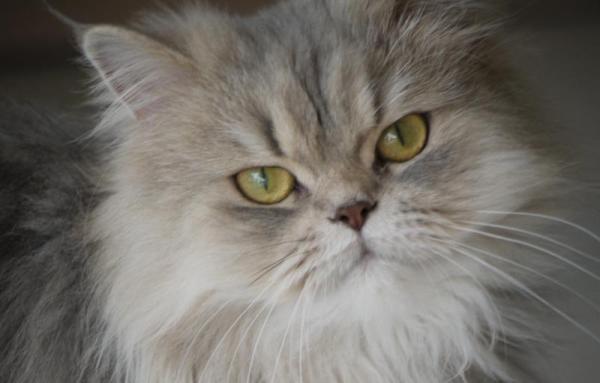
The Persian cat is the feline with the most widely recorded pedigree. This very old cat breed comes from old Persia (modern-day Iran), hence its name. It was introduced to Italy in 1620. Nowadays, there are many different varieties of Persian cats.
Moreover, each type of Persian cat can be subdivided into various subtypes according to their characteristics, comprising a very extensive list which can be a useful frame of reference, although classifying these cats requires meticulous observation.
If you continue reading AnimalWised we will show you the main types of Persian cats and some of its most colorful variants.
What do Persian cats look like?
Most cat lovers know what a Persian cat looks like, at least roughly. The Persian cat is characterized by its broad face, flat nose, round eyes and small ears. Its long and thick coat is very silky, which needs to be brushed daily, comes in a multitude of different colors, as you'll see below.
There are types of Persian cats in solid colors, some with spots and others with speckles. Male Persian cats only come in two colors, while females can come in three colors.

What is the Persian cat's temperament like?
Persian cats sleep a lot. This breed seems to be very aware of its beauty and likes to be pampered, but doesn't like being handled too often - they seem to have all the stereotypes about cats.
The Persian is an aristocratic cat that requires much more attention than any other breed. It doesn't like being left alone and even follows family members around so as to not get separated from them. It is a very dependent pet, and must be carefully groomed and bathed to prevent tangles and knots in their coats.

How to care for a Persian cat's fur
This breed needs to be washed more regularly than other cats. The Persian cat's coat is made from a very thick fur which should be bathed and brushed with professional tools, pet dryers and other specialized utensils. There are specific beauty and hygiene products for Persian cats in the market.
Moreover, it's advisable for its coat to be refined by a professional; the main way to enjoy an impeccable Persian cat is by getting a specialized pet groomer to regularly trim its fur. We also recommend learning how to remove knots and tangles from a Persian cat's coat.

How to care for a Persian cat's health
Visiting the vet regularly is a requirement. They will monitor your cat's health and administer the appropriate vaccines, and will provide vitamin supplements if necessary. When they preen themselves, Persian cats have a tendency to swallow dead hair from their coat. This might cause hairballs to form in their digestive tract. Malt should be given to Persian cats to prevent the accumulation of hair.
If you see that the cat has trichobezoars - the scientific name for hairballs - causing intestinal obstruction, one of its paws should be smeared with paraffin. When it licks the paw to clean it, the cat will ingest the paraffin which will help it to get rid of the hairballs.
If you're not absolutely sure what type of Persian cat you have, you can ask a professional for advice. But if they are unable to help you, keep reading:
Types of Persian cat
There are many different types of Persian cats, which breeders classify according to the color and pattern of their coat. The Cat Fanciers' Association, for instance, classifies Persian cats into:
- Solid division: White, blue, black, red, cream, chocolate or lilac. Eyes are bright copper, but solid white Persian cats can also have blue or odd-matched eyes.
- Silver and golden division: Chinchilla (usually smaller, white with black tips), shaded silver and gold, blue chinchilla and blue shaded silver and gold. Eyes are green or green-blue, rimmed in black.
- Shaded and smoke division: Shell and shaded cameo, cream, tortoiseshell and blue-cream. Black, blue, cream, red, tortoiseshell, blue-cream, chocolate, lilac, chocolate tortoiseshell and lilac-cream smoke. Eyes are copper.
- Tabby division: Classic, mackerel or patched tabbies can come in silver, blue silver, red, blue, brown, cream, cameo and cream cameo. Eyes are copper, although silver tabbies can have green or hazel eyes.
- Particolor division: Tortoiseshell, blue-cream, lilac-cream and chocolate tortoiseshell. "Particolor", in this case, means "patched". Eyes are copper.
- Bi-color division: Including calicoes, which have three colors. They can be smoke and white as well as tabby and white, as well as other solid color combinations. Eyes are copper, although silver tabbies with white can have green or hazel eyes.
- Himalayan division, or Colorpoint Longhair: They have a very distinctive appearance due to their being originally bred with Siamese cats - hence their coloring. Himalaya cats are mostly white or fawn, but their face and extremities can be of almost any color. Their eyes are always blue.
Some associations classify Exotic Shorthairs - which a similar flat face but a shorter, more manageable coat - as the same breed as Persians. Similarly, some associations consider the Chinchilla Longhair a separate breed, since their nose is longer (and they can breathe better).
The International Cat Association, on the other hand, classifies Persian cats into three big groups: Traditional (with rich, deep colors), sepia (paler) and mink (the lightest of all).

Do you know what type of Persian cat you have?
Send us a photo of your Persian cat below in the comments section, and we will try to help you as best as possible. Thank you for visiting AnimalWised!
Sir Winston's cat, for example, is a solid blue Persian, probably the most traditional variety of this breed. Thank you for sharing a picture!

If you want to read similar articles to Types of Persian Cats, we recommend you visit our Comparisons category.